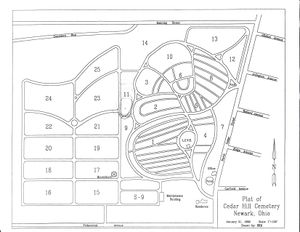Difference between revisions of "Cemeteries"
| Line 15: | Line 15: | ||
== 6th Street Cemetery == | == 6th Street Cemetery == | ||
| − | + | The Sixth Street Cemetery, known today as Sixth Street Park was Newark's primary cemetery until Cedar Hill opened in 1850. The cemetery gradually became sidelined by Cedar Hill and in 1875, the remaining graves were transferred to Cedar Hill and the cemetery was transformed into a park. When plans for the National Heisey Glass Museum were established near the cemetery's original location in 1973 and construction began, there were a number of skeletons and tombstones unearthed on the site. <ref> Bell, J. (1992, July 22). City workers move bones to cemetery. The Newark Advocate. </ref> | |
| − | |||
[[6th Street]] | [[6th Street]] | ||
Revision as of 08:37, 26 February 2015
Licking County has two main cemeteries: Cedar Hill Cemetery and the 6th Street Cemetery.
Cedar Hill Cemetery
Cedar Hill was opened in 1850. [1]. It covers 113 acres and is the largest cemetery in Licking County. Cedar Hill is owned by the City of Newark and contains about 36,000 graves. [2] The first official internment on the books was that of Mary Vandine, who died of paralysis and was laid to rest in December 1850. [3]
There is a house on property of the cemetery that served as an office and residence for the cemetery's superintendent. The house which was built in 1879, along with the the office depot and cemetery chapel are on the National Register of Historic Places. [4] Today, volunteers are working to digitize the information in the old internment books to a computer database.
In 2001, Cedar Hill found itself nearly $100,000 in debt. Due to mismanagement by the cemetery's superintendent, bills went unpaid and funds mishandled. A large portion of money from the cemetery's contingency fund was used to cover the debt. [5]
Famous People of Cedar Hill
6th Street Cemetery
The Sixth Street Cemetery, known today as Sixth Street Park was Newark's primary cemetery until Cedar Hill opened in 1850. The cemetery gradually became sidelined by Cedar Hill and in 1875, the remaining graves were transferred to Cedar Hill and the cemetery was transformed into a park. When plans for the National Heisey Glass Museum were established near the cemetery's original location in 1973 and construction began, there were a number of skeletons and tombstones unearthed on the site. [6]
References
- ↑ Bell, J. (1992, August 19). Remains from park now rest in peace. The Newark Advocate, p. 1.
- ↑ Cedar Hill Cemetery. City of Newark. Retrieved February 26, 2015
- ↑ Keirns, A. (2005, December 29). Old cemetery records offer poignant view of history. Old Town Newspaper.
- ↑ Jones, S. (1983, February 3). Life in Newark cemetery can be scary and calls for adjustment, family finds. Columbus Citizen Journal, p. 9.
- ↑ Mallett, K. (2001, August 28). City-run cemetery $100,000 in debt. The Newark Advocate.
- ↑ Bell, J. (1992, July 22). City workers move bones to cemetery. The Newark Advocate.
